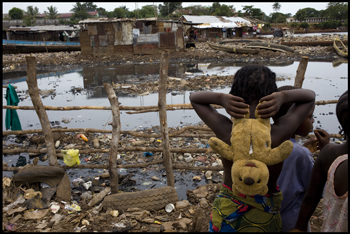Global Health in Focus: Dominic Chavez

Young kids overlooking their neighborhood, Kroo Bay, a slum in Freetown, Sierra Leone filled with shanty structures, overrun with garbage and extreme sanitation issues. This unsettling environment creates a long list of health conditions due to the lack of clean water. Some of the biggest issues they are facing are polio, ringworm, typhoid fever, and malaria, not to mention a high incidence of child malnutrition.
<< back to Global Health in Focus
Bio
Chavez’ photographic career began at age 19 at The Denver Post where he freely explored and interwove creative vision, personal documentary, and photojournalism. Six years later, The Boston Globe brought him east, where he worked until the summer of 2008.
Since 1991, Chavez has covered a wide range of domestic and international issues. He has reported from the front lines of Iraq and Afghanistan to the war-torn streets of Angola. He has recorded the effects of the ongoing drug war in Colombia, and documented many health issues facing the nations of Africa. Presently, he is focusing on global health issues.
Chavez has produced six books: Well Being with Johns Hopkins University, From the Ground Up with the Elizabeth Glaser Pediatric AIDS Foundation, Airborne with the World Health Organization, A Line Drawn in the Sand with Harvard University, Passion Beyond Normal with CGIAR, and AIDS in Nigeria with Harvard University.
Chavez received a Kaiser Family Foundation Media Fellowship in 2007–2008 and has been recognized with many awards. In 2004, he won First Place International in Pictures of the Year International for his work during the Iraq War. Also in 2004, Dominic received the Media Excellence Award by the Global Health Council for his work on the AIDS crisis in Africa. In 2000, he was awarded Photographer of the Year from the Boston Press Photographers Association for his work in Afghanistan, Angola, and Colombia.
Q & A with the Artist
1. Why and how did you decide to become a documentary photographer?
It’s a combination of many reasons. I love people. I love photography. Combined with my curiosity and the moments in our time that affect all of us.
2. Why and how did you decide to focus on global health?
For many years I photographed war and conflict, including the front lines in Iraq and Afghanistan. I then started documenting issues and witnessing the casualties of AIDS, drug resistant TB, and malaria; I found that these dangers were just as real as any war zone. I saw it as a kind of undeclared war in which the most vulnerable people had devised ways of staying alive, but all their plans were no match for the trouble around them.
3. What is the main point/understanding that you'd like the viewer to get out of your work?
In the last couple years, I have spent many days with the head of the Reproductive and Child Health Department in the Ministry of Health and Sanitation in Sierra Leone. His name is Samuel Kargbo, a doctor who committed his life to improving health conditions for women. He said what motivated him was witnessing a group of men carry a woman into his hospital in eastern Sierra Leone. They told him they had carried her for three days. She was pregnant, and nurses rushed her to the operating table. “Before we could lay hands on her,’’ Kargbo said, “she died. I will never forget her.’’ That’s my goal as well. I want others not to forget, feel as if they can’t look away, or stop thinking about [the people they see in my photographs]. I want to bring [viewers] inside the lives of these people on these hidden frontlines.
4. What have you personally gained from your experiences and how have
they influenced your subsequent work?
These experiences have shape most of my adult life. Maybe this is why I’m so zone focused. My first steps were focused on developing the craft and learning to see through the lens, like learning a new language. I knew it would take many years to have a strong creative voice. One of my biggest fears was to have all the heart and no craft. I see my images as the middle voice hoping they will create some dialogue.
5. What kind of responses has your work received from the health/science communities in the US?
It is difficult to say how the work is being received, but my photographs have been used as examples of lives lost, or in some cases, a second chance at life. The work has been widely published around the world and exhibited in many health conferences including the US.
|